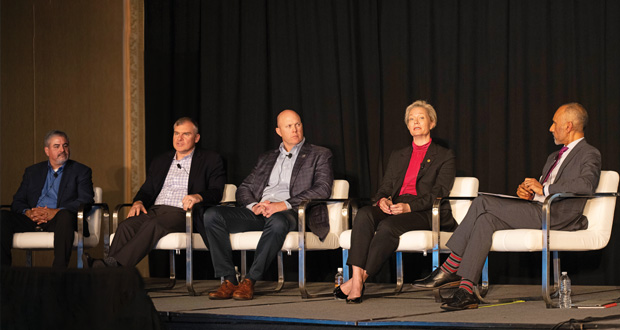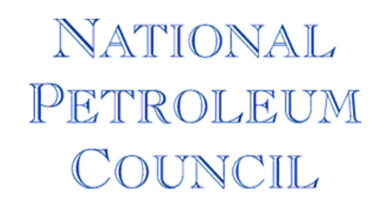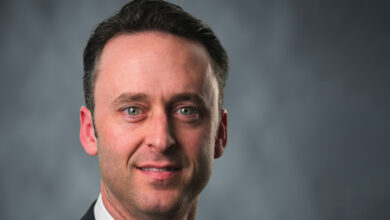Industry leaders cite innovation, collaboration as key ingredients to maximize asset performance
Mentorship programs and investments in innovative solutions among ways organizations are enhancing value of workforce, existing rigs

By Stephen Whitfield, Senior Editor
A drilling campaign requires the coming together of a diverse set of assets – including the rig and all its associated equipment; engineers, rig crews and a whole host of support technicians and staff; and a variety of downhole and safety technologies that help people do their jobs better. Every piece is critical to ensuring a safe and efficient operation.
At the 2024 IADC/SPE International Drilling Conference in Galveston, Texas, on 6 March, a panel of industry leaders discussed their approaches to the development and utilization of those assets in a changing environment, recognizing that collaboration will be key to keep the industry moving forward.
For SLB, technology is at the root of everything the company does. Collaborating with companies in different domains has been critical to unlocking new efficiencies, Lyndal Cissel, President – SLB Americas, said during the plenary session. One such collaboration has been taking place over the past five years, with SLB working with Chevron and Microsoft to accelerate the adoption of digital systems in energy applications.
The partnership encompasses the use of both DELFI, SLB’s data management platform that allows companies to process, visualize, interpret and obtain insights from multiple sources of E&P data, as well as Microsoft’s Azure cloud computing platform. SLB has also contributed the open-source code of the DELFI system to the OSDU data platform, a cloud-native subsurface reference architecture that other companies can use as the foundation for their own data management systems. Opening DELFI code to the larger industry can help “bring innovation and efficiency” forward, Ms Cissel said.
“What DELFI did was it really started launching our ability to look at the future and bring everything together,” she said. “The future is uncertain. We have an incredible amount of data that we don’t actually consume, and no one company is going to have the answer or physical solution to handling all of that data. Partnerships and alliances will allow us to bring not just the subsurface planning but also the operations insight where we can look at all of that information from a rig. It is really going to be our next launch for success.”
Driving human capital forward
People is another critical asset for the industry. But to attract and retain new talent, she noted, it is important for the industry to highlight its role in advancing new technologies. “I believe oil and gas will be with us for a long time – longer than any of our careers. The technologies that allow us to remove the mundane parts of repetitive tasks and give our employees purpose and the ability to use their intelligence will be key. Producing an exciting product or solution is really what’s going to bring our human capital forward.”
John Sanclemente, VP of Wells at Chevron, also noted the importance of collaboration in order to develop innovative solutions for the industry. “If you think about the global energy system of the future, we have to continue to work in partnership. It’s going to demand that we collaborate, that we continue to innovate, and continue to work on breakthrough technologies.”
Mr Sanclemente outlined four priorities companies should consider when developing new technologies. First, the technologies must enable companies to operate more efficiently, driving down costs and cycle times. Second, they must allow companies to deliver higher returns to their shareholders. Third, they must help companies decarbonize. And lastly, they must help to unlock the potential of the workforce.
“We have so many opportunities for us to continue to deliver affordable, reliable and cleaner energy. That has to come through the human capital that we all have. We have to help our people to do their best,” he said.
Mike Lennox, Senior VP – US Land Operations at Helmerich & Payne (H&P), also stressed the importance of human capital as an asset for the company’s success.
“When we bring folks on, we’re looking for people that aren’t looking for a job but for a career. When we onboard and train them, we want them to become people who will be here for 20-plus years. At H&P, every year we’re recognizing people for 35 or 40 years of service,” he said.
Training, communications and processes are the company’s three areas of focus when it comes to developing and retaining talent. H&P has developed a standardized six-month training program for its short-service employees (SSEs). The SSE Path to Graduation program utilizes three types of teaching – visual, auditory/verbal and kinesthetic – to accommodate employees with different learning styles and backgrounds. The program also encompasses a mentorship element where SSEs receive one-on-one support from experienced personnel.
Cash bonuses are offered to tenured employees to incentivize their participation in the program. “When I was starting out my career on the rig, it was very easy to quit or give up if you were a young roughneck and nobody took you under their wing and treated you like family,” Mr Lennox said. “It’s important to incentivize potential mentors to actually take on that role.”
He also noted the importance of two-way communication in this onboarding process. In the SSE program, mentors provide transparent feedback on the SSE’s progress, while SSEs are also encouraged to give their own feedback to the mentor so they can see that their input matters.
Beyond that, H&P’s senior leadership also holds weekly FlexCalls with rig crews focusing on safety and performance. These calls allow employees to discuss observations on the rigs and voice any concerns they may have. Further, the calls offer an opportunity for crews on different rigs to connect with one another, as well as with employees in other parts of the company who support the work that goes on at a rig site.
“It’s a two-way communication for all the folks in our organization,” Mr Lennox said.
Taking rig technologies to next level
People have also been a priority for Transocean, especially as the offshore industry began its recovery from the downturn and rig demand increased. Roddie Mackenzie, EVP and Chief Commercial Officer at Transocean, noted that the company hired approximately 1,600 people last year, driven in part by the need to execute eight large-scale rig reactivation and upgrade projects, as well as nine international rig moves.
It’s also important for companies to think about how people fit into developing their core business, Mr Mackenzie said. For Transocean, that meant figuring out how technologies can help draw greater efficiencies out of its workforce and rigs. The company has divested 78 rigs since 2014, most of them going to scrap yards. The 37 rigs remaining in its fleet are almost exclusively high-spec ultra-deepwater and harsh-environment rigs.
Mr Mackenzie said during the plenary session that the company was “essentially 100% utilized” on all of its rigs with 12,000-psi BOP systems and above. Last year, the company also deployed the industry’s first 20,000-psi BOP system on the Deepwater Titan drillship.
“We cannot afford to deploy our capital on building new rigs; this equation doesn’t work,” he said, noting that the company is choosing to focus instead on taking its technologies and rigs to the next level. “Investing in innovative solutions and the digital transformation has been very important to us because, at the end of the downturn, that’s what sets us apart and positions us to help move the industry forward.”
In 2021, the company deployed HaloGuard, a safety system that integrates a wearable locating device with drill floor equipment and machine stoppage controls.
In 2023, the Transocean Encourage semisubmersible used a drilling assistance module, working in concert with other smart modules on the rig, to drill a fully automated hole section on a well at the Heidrun field in Norway. The rig team executed a total of 51 connections without any intervention from the driller.
Mr Mackenzie said boosting technological capabilities is critical for helping its personnel do their jobs more safely and efficiently, either by keeping them away from hazardous equipment or by automating repetitive tasks and allowing them to focus on other tasks. The boosts in safety and efficiency gained from investments into innovative technologies all translate into helping the company do more with less.
“Our view is that efficiency opens the driller to make more projects,” he said. “If you can bring the cost of the project down, there will be more work for you. It may be slightly counterintuitive, but the better you are, the more work that you enable.” DC



